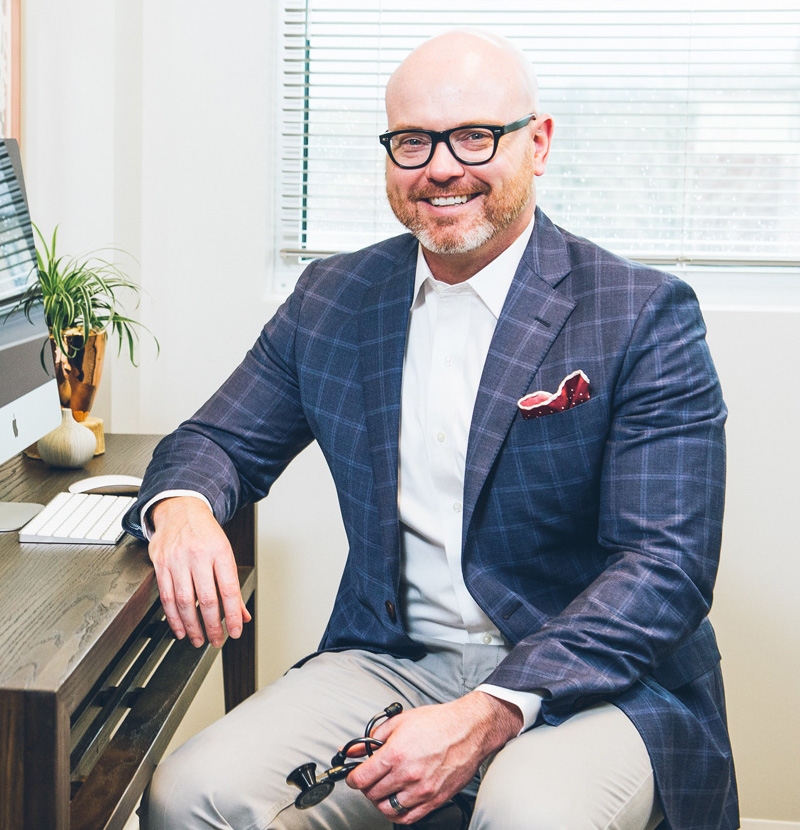Download file | Play in new window | |
This month, my podcast copilot Jen Justus and I cover part one of a three-part series I’m calling “The Three Pillars of Health.”
My experience, especially over the last year, has crystalized for me that all meaningful progress in a person’s health journey tends to track through one of three pillars. You make meaningful progress by optimizing either:
- Eating — the way you feed your body
- Moving — the way you move and challenge your body physically
- Recovering — the way you recover your body on a daily basis
Here in part one, we discuss eating — a vitally important topic that really hits home for both Jen and I. Specifically, we take an in-depth look at how we should feed our bodies and how to optimize our diet.
How to Improve Your Eating Habits
Jen and I began our professional journey together about 10 years ago in the obesity space, dealing exclusively with weight and weight-related diseases. We have thousands of hours of experience with real humans who really struggle with weight, and I think we’ve uncovered a lot of really interesting truths in this area.
To start looking at eating as the first pillar of health, we’re going to take it in layers: how we need to think about eating, how we physically experience eating, and how we emotionally experience eating.
Let’s start with thinking.
Layer 1: How to Think About Your Eating
The purpose of the human body is to stay alive. Every system and backup system we have is designed with a singular goal: don’t die.
We need to eat — to take in energy — so we can achieve that goal of not dying.
Prior to the emergence of mass agriculture in the late 1800s and early 1900s, obesity rates in the world were less than 5% for all of documented human history. Now, obesity rates are approaching a third of the U.S. adult population. We have a real problem.
Before mass produced food, humans spent the majority of their time not eating. You didn’t wake up and go right to the pantry and start nibbling. You certainly didn’t have a snack every two hours or late at night. You got up and went about your business — and if you were lucky, you had a meal that day.
We led a very fasted lifestyle, and our bodies adapted well to that. Now, we live in an era of abundance, and we’re not doing very well with all this excess. That’s what metabolic disease is, a disease of “too much” — too much grain, too much blood sugar, too much blood pressure, too much cholesterol. And this “too much” is fueling diseases like diabetes, heart disease, and cancer.
To overcome this abundance, today we need intentional deprivation with very focused periods of time to eat. That’s why we believe the best dietary strategy for most people is a fasted lifestyle. There will be a handful of people where this doesn’t work well, but for the vast majority of people, fasting for at least 12 hours a day is the basic jumping off point for health.
Freedom in Discipline: A Fasted Lifestyle
We talk about freedom in discipline a lot. But it’s not about being disciplined for discipline’s sake. It’s about being disciplined in the things we know will map us toward what we want. If we want health, vitality, and longevity, the first pillar of health to attack with discipline is how we feed our bodies.
Often, people view freedom and discipline as two opposite ends of a spectrum. In reality, they’re interconnected; you can’t have one without the other.
Jen has shared that all the great things in her life came from discipline — her career, her marriage, her spiritual walk — and applying that same discipline to her health journey freed her from the stress, anxiety, guilt, and shame that plagued her previously. In my own life, I’ve found my personal freedoms expand since I fired “fat Aaron.” Over five years ago, my career, marriage, parenting, and ability to lead suddenly all started to move in a positive direction — all because I got control of what I was putting in my body as a source of fuel.
It’s true that being disciplined with food can be overwhelming. When you’re inundated with diet options and “eat this not-that advice,” it can get too complex to be realistic. And when overwhelm sets in, people revert back to what they’re used to.
But there’s something about a fasted lifestyle that’s different. It’s simple. It reduces decision-making. And it really moves the needle.
The Breakfast Myth
One of the most difficult hurdles to fasting for many people is unlearning the popular thought that breakfast is the most important meal of the day.
Our culture believes you have to fuel yourself first thing in the morning or you’re not going to be productive. That’s a myth, and the product of one of the greatest marketing campaigns ever deployed — by Grape Nuts in 1944, to sell more cereal.
Now, I do agree that your first meal — the meal at which you break your fast — is your most important meal of the day. You’re the most biochemically vulnerable at that point. What I disagree with is the belief that this has to happen first thing in the morning.
Approach With Patience and Curiosity
The thinking part of adopting a fasted lifestyle is important. Like any behavior change, it can be challenging at first. If you don’t have your mindset wrapped around fasting as a concept, it will be more difficult to persist through those challenges.
If this resonates with you, and you haven’t given fasting a go for six to 12 months, I would encourage you to be curious and patient.
Personally, it took me about six months to make fasting a consistent practice even after I knew I wanted to do it. I was grumpy because I woke up hungry, but I realized that was a completely learned behavior. It was my brain saying, “Where’s my dopamine hit?!” — ideally in the form of some crunchy, sweet carbohydrates.
This unlearning is part of the thinking process. For Jen and her journey into a fasted lifestyle, I’ve seen that unlearning process evolve first-hand. While committed to her goal, she allowed herself to be flexible as she worked with her body to figure out fasting.
She’s stayed consistent with that, never giving up despite her more complex case, and today she’s completely different. She’s been able to achieve an even deeper level of discipline, which yields more freedom and allows her to apply new energy and focus to her discipline. It’s a wonderful cycle of positive momentum.
After trying every diet on the planet, Jen has undone decades of confusion and complexity through simple fasting.
Her top advice for getting started is to set your environment up for success. If you open your pantry first thing in the morning and see all those breakfast foods, that’s what you’ll want. Cleaning those out can help you stay on track.
For me, I find that getting out of the house first thing in the morning works well. I have two children, and I don’t want to make eating strange for them. So, I work out, grab my coffee, give them a kiss, and head out. On the weekends, it’s harder for me to be successful at fasting because eating is all around me. But at the office, all we have is water and coffee, and I forget about food entirely once I get busy with work. It’s serving me well.
Today, the strategies I used to eliminate 40+ pounds of fat off my body are the same strategies I’m using five years later to maintain that weight loss.
There’s so much freedom I experience from a fasted lifestyle. I can apply that newfound surplus of energy, creativity, and decision-making capacity to other things.
Layer 2: Physically Feeling a Fasted Lifestyle
In the next layer of considering how we should feed our body, we’ll focus on the typical physical experience of a fasted lifestyle.
There’s an element of transition and adaptation to a fasted lifestyle. Some people take to it like a fish to water. Some take longer to adjust.
It took six months for my body to recognize that though I was feeling the desire to eat and the pangs of hunger, it wasn’t because I actually needed to eat. I eat to give my body energy, and there was plenty of energy available all over me in the form of fat.
So I told my body, “No, I’m not feeding you. Go get that energy. It’s there, in my belly. I’m in control.”
Right away, I had more energy. I was no longer facing decision-making fatigue. I was creating a famine where my body was eating itself, which is what it’s designed to do — clean out the stored energy.
I slept better. I moved better, and I was able to exercise more effectively. The primary work in those first six months was getting my mind right and then allowing my body to feel what it was going to feel as it adapted to this new lifestyle.
Jen’s experience of adjusting to fasting was a little more difficult than mine at the outset. Her body just didn’t want to be in a fasted state. She experienced headaches and was very tired in the mornings, though she always perked up when she had her first meal of the day.
Incorporating weekly coaching calls at the start of her fasting helped immensely. Her coach would talk her through what was happening to her body and remind her that those feelings of discomfort would let up. She immersed herself in an environment of encouragement to get her through that initial adaptation phase. Once she did, she experienced the same physical benefits I did, and then some.
The physical experience of a fasted lifestyle is a two-step process. Step one of adapting to a fasted lifestyle might be immediate, several months, or even a year and a half, as it was for Jen. I encourage you to stay the course, because step two is complete freedom, simplicity, and a feeling of lightness in your physical body.
If you need to, start slow so your body can feel better as it adapts to fasting. Pick up a cadence that works for you. In the beginning, Jen only fasted for three days a week. You don’t have to come out of the gate with guns blazing.
Patience, curiosity, and persistence are the keys to being physically successful at improving the way you feed your body.
Layer 3: Emotionally Feeling a Fasted Lifestyle
There’s a bit of overlap with your feelings and the physical, but what I’m primarily talking about here are the spiritual and emotional feelings that come from a disciplined fasting execution.
For me, a fasted lifestyle brings confidence. It’s clarity, simplicity, and a multiplier of effort. It’s like a flywheel — I still put forth effort, but it takes very little to keep moving. In the beginning, it took a lot more force. But once that flywheel gets going, I can take my hand off it for a bit.
We’re coming off the holidays. I was far from perfect with my eating habits, and years ago I would’ve done serious damage. But this time, it didn’t matter. It was a short time, and I could put my hand right back on the wheel to keep that positive momentum going.
Figuring out how powerful a fasted lifestyle is has given me a unique insight: Being disciplined in the things that are most important allows me to achieve freedom. A lack of freedom and discipline equals chaos and complexity. Whenever there’s complexity in my life, it’s either because:
- It doesn’t matter and I’m not paying attention to it.
- It does matter, but I haven’t applied discipline yet.
Every area where I’ve committed to being disciplined, I’m experiencing downstream freedom. It’s counterintuitive, and it requires transition and adaptation to get that flywheel going.
Final Thoughts
If I could recommend one big takeaway from this post, it’s to figure out what’s most important to you and realize there’s no way to get those results without being disciplined in the things that will map you there.
Also, be patient, be kind to yourself, and be curious. Never give up. And find at least one person who has your best interests at heart (who’s not trying to sell you anything) who can encourage you to stay the course.

Dr. Aaron Wenzel is a concierge physician specializing in the care of fast-moving entrepreneurs, executives, and public figures in the Nashville, TN area. Dr. Wenzel’s diverse life experience and extensive training in family medicine, emergency care, nutrition, and hormone replacement therapies give him the unique platform to provide unmatched care for his patients.








